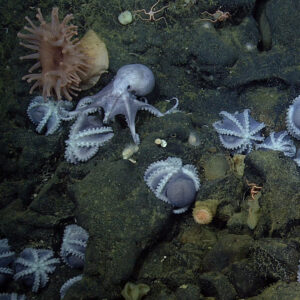Citation: Barry, J.P., Litvin, S., Devogelaere, A., Caress, D.W., Lovera, C.F., Khan, A.S., Burton, E.J., et al. (2023) Abyssal hydrothermal springs—Cryptic incubators for brooding octopus. Sci. Adv., 9, eadg3247. doi10.1126/sciadv.adg3247
Ectotherms (fish, reptiles, and invertebrates) are animals that cannot make their own body heat, opposite of endotherms or mammals. Most of the ectotherm lifecycle, from embryo to adulthood, is heavily influenced by temperature. In the deep sea, ambient water temperature is 4 C (39 F) on average, a major challenge to the invertebrates and fish that live in the deepest parts of our oceans. Consequently, deep sea animals have very slow metabolisms and long lives. The cold temperatures also make it difficult to raise young as the cold lowers birth rates and slows embryonic development. Thus the trend for deep sea creatures is to have fewer, larger eggs than their warm water counterparts. In fact, embryonic development rates for cold water species can be 4 to 33 times lower than for related warm water species!
Marine scientists at the Monterey Bay Aquarium Research Institute (MBARI) are studying a massive octopus brooding site in the deep ocean off the coast of central California, affectionately called the Octopus Garden. Here, a species of deep sea octopus (Muusoctopus robustus) appears to have found a life hack. These clever octopuses are using the warm waters of an old sea mount to warm their broods, which allows them to both have more children and accelerate the development of their offspring. Additionally, since this species dies shortly after mating, the carcasses of M. robustus adults provide a buffet for other deep sea creatures. It seems that this seamount oasis provides wins for all, though MBARI researchers are investigating whether that really is the case. Is faster, warmer development truly better for these octopus young? And what else can this bustling seamount tell researchers about the influence of hot springs on deep sea biology?

The warmer the better?
The research team used an impressive collection of technology to study the octopus garden, including ROVs, seabed mapping, robots, and timelapse footage over the course of 12 research cruises from 2019-2021. They were able to generate detailed bathymetry maps, capture data on temperature and oxygen, and used imagery and video footage to observe the behavior of the octopuses and other fauna around the sea mounts. They found that water temperature ranged widely, from near 11 C (51 F) at the warm rock surface of the seamount to 1.6 C (34F) a short distance away in the surrounding ambient water.
Octopus eggs are very sensitive to temperature. At the frigid ambient temps, the eggs would have taken 10 years to hatch! But at the temperatures in the seamount crevices, the eggs only took 2 years to develop and hatch. This meant that the octopus young on the seamount developed five times faster than they would without its warmth!
While the seamount facilitates octopus reproduction by making it easier for mates to find each other and by speeding up development, is the faster development really beneficial to octopus young? Too much warming can be stressful for organisms and can harm offspring by speeding their development along too quickly. M. robustus hatchlings in warmer temperatures were larger than those in cooler temperatures, meaning they may be more capable foragers early on and less vulnerable to predators. The hatchlings from cooler incubation temperatures however benefited from having larger yolk reserves, which protects against starvation. This study wasn’t able to investigate whether the hatchlings from warmer crevices had developmental issues but the success of most broods seemed to be higher than average for this species. Perhaps this means that the benefits of raising young at warmer temperatures were enough to outweigh any potential downfalls.

A Garden Feast
The video footage showed that the seamount was also rich in other types of sea creatures, including anemones, deep water coral, sea stars, crustaceans, sponges, worms, and fish. The researchers initially weren’t sure what was attracting all this life – the warm seamount or the large number of octopus? But after analyzing several thousand hours of video footage, it seemed there was a strong correlation between how many octopus were present and the abundance of other animals. The seamount was also littered with dead M. robustus, which died after mating and were quickly scavenged by surrounding sea life. Creatures that didn’t scavenge on the adults preyed on the eggs, or on the other creatures, and the seamount became a thriving ecosystem of bustling sea creatures, a rarity in the deep sea.
Carbon is essential to life but is typically hard to get in the deep sea. Since sunlight cannot reach the depths, photosynthesis can not occur. More-active seamounts provide enough heat energy and chemicals to support chemosynthetic bacteria, which act in the place of plants or phytoplankton to provide carbon for animal life. By comparison, the water seeping out of the rocks was warm but not scalding, and no chimneys spouted sulfur or supported the red tube worms, feathered crabs, or other weird life typical of hydrothermal vent systems. Yet this calmer system seemed to be just as productive. The researchers attributed the massive amount of carbon provided by dying octopuses to the bounty of life that the seamount is able to support. If this seamount didn’t provide such a handy service to octopus reproduction, perhaps the other life in the area wouldn’t be able to congregate there.
This conclusion led the researchers to see the Octopus Garden as a critical area for protection. Fortunately, this particular garden lies within the Monterey Bay National Marine Sanctuary, which is protected from deep sea mining and unregulated deep sea fishing. The scientists at MBARI want to know how common mild seamounts like this one are in the deep ocean. Perhaps if these oases are common, then deep sea life is more abundant than we thought. Either way, the researchers hope that discoveries like this will prove that the deep ocean should be protected and conserved.
Cover image: The Octopus Garden at Davidson Seamount. Credit: Monterey Bay Aquarium Research Institute.

I am a masters student at the University of Rhode Island, studying the ecology of the harmful algal bloom genus, Pseudo-nitzschia. My work is interdisciplinary and revolves around coastal health, water quality, and public engagement with science. In my free time I enjoy doing crafts, writing, cooking, and exploring the outdoors on my feet or a pair of skis.

